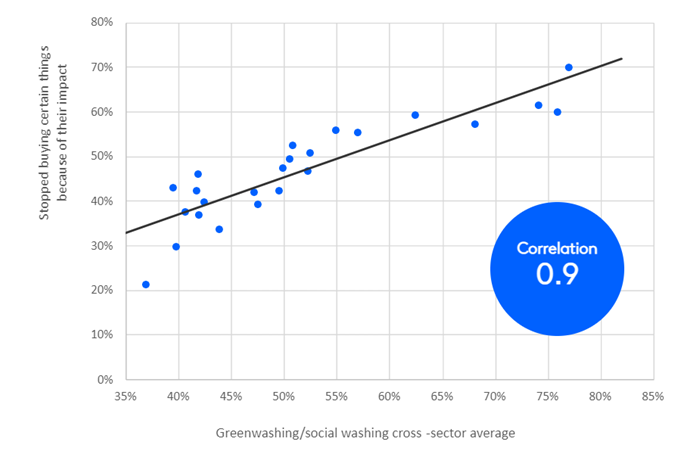We are in the middle of a climate crisis. We need to enable behaviour change at scale to disrupt the climate trajectory, but while 84% of people globally are concerned about brands’ involvement in environmental and social issues, only 27% of consumers act in a way that addresses these concerns. There are many barriers to encouraging change – and perceived greenwashing is one of them.
People today feel vulnerable – 70% expect to personally feel the impact of climate change in their lifetimes, and 63% already feel impacted. And as 61% of people pay attention to environmental & social issues in the news, they hear much about greenwashing as they do so.
Trust is the currency of making change happen. We ask people to take a leap of faith in switching to more sustainable brands – and it’s critical that we root this faith not in blind hope, but deep trust.
In our Sustainability Sector Index (SSI) we asked consumers if they have seen or heard any misleading or false information given by brands. We were amazed to see 52% of people agreeing with this statement, on average, across all the 42 sectors surveyed. How can we expect consumers to change their purchasing behaviours, if they can’t trust that your brand is doing what it says?

Even more worryingly, the data shows that the more people perceive greenwashing, the more likely they are to drop those brands out of their consideration set and reject them.
Looking at this by age band, we see that it is the younger cohorts, aged 18-34, who have the worst perceptions of greenwashing. Given that science tells us we are only going to experience more extreme climate impacts and events, we need a volte-face to shift from greenwashing disillusion to developing deeper trust.
“Today’s greenwashing is tomorrow’s scandal. It fundamentally erodes what is already quite fragile trust in brands and businesses. As it goes further & further up the regulatory and legal agenda, it is going to increase reputational risk. We really need to step in to avoid this." Rob McFaul, Co-Founder, Purpose Disruptors.
The first pillar, Integrity, is the base foundation of trust. Having clear commitments, doing what you say you’re going to do, and communicating this with honesty. In a post-truth world though, and in one where poor perceptions can be caused involuntarily, people can find it hard to assess integrity’s… integrity.
The second I – for Identification - represents connection at a human level, one of the most powerful sources of trust in times of disruption and uncertainty. We are hard-wired to identify with those who share our goals and values, and trust forms through these relationships.
Inclusion is the third pillar, the need to create closeness. When people feel like they are included and they belong, they feel more invested in a brand and its actions. They are more empowered to make better choices.
With these three elements united, people can build deeper, trusted relationships with their brands of choice. Where trust thrives, there is less room for greenwashing concerns to grow.
Moreover, people need to see brands deal clearly with their specific sector sustainability issues. If you’re a bank, deciding to plant trees may not tackle your consumers’ priority issues head on. And temporarily jumping on a bandwagon, for example by changing your brand colours solely for Pride week, can more than dissipate the impact of the intended rainbow.
Good intentions can often become greenwashing concerns. Add to this the consumer data that 67% of people say they worry brands are involved in social issues just for commercial reasons, and that 57% feel it’s really hard to tell which products are good or bad ethically or for the environment, then the three Truth pillars become even more essential bedrocks.
Avoiding greenwashing perceptions therefore has to start from within our businesses and within our own roles. As Char Love, Global Director of Advocacy at Natura&Co, puts it: ‘Systems change has to focus on both culture change and policy change, in order to avoid merely greenwashing’.
Supporting this perspective, it is interesting that in our recent Kantar Sustainable Marketing 2030 survey, the three lowest attributes measured were around:
- Decision-making
- Profit and loss models
- The investment decisions of the company not having environmental and stakeholder impact integrated into them.
This strongly indicates that there is still hesitancy in many businesses towards fully committing minds, finances and actions to championing sustainable solutions. No-one expects perfection from day one and all journeys have minor stumbling blocks along the way. But perhaps we could say that it is little wonder, given the data, that greenwashing concerns can invidiously creep from their internal roots, to becoming externally evident. Whether inevitable, or entirely unintentional, brands cannot afford to paint over these precarious green cracks in their armour.
This article is part of Kantar’s 6 article series, taken from our Making Sustainability Real conference, available on demand here.
People today feel vulnerable – 70% expect to personally feel the impact of climate change in their lifetimes, and 63% already feel impacted. And as 61% of people pay attention to environmental & social issues in the news, they hear much about greenwashing as they do so.
Trust is the currency of making change happen. We ask people to take a leap of faith in switching to more sustainable brands – and it’s critical that we root this faith not in blind hope, but deep trust.
Greenwashing – a deepening concern that can lead to brand rejection
In our Sustainability Sector Index (SSI) we asked consumers if they have seen or heard any misleading or false information given by brands. We were amazed to see 52% of people agreeing with this statement, on average, across all the 42 sectors surveyed. How can we expect consumers to change their purchasing behaviours, if they can’t trust that your brand is doing what it says?

Even more worryingly, the data shows that the more people perceive greenwashing, the more likely they are to drop those brands out of their consideration set and reject them.
Looking at this by age band, we see that it is the younger cohorts, aged 18-34, who have the worst perceptions of greenwashing. Given that science tells us we are only going to experience more extreme climate impacts and events, we need a volte-face to shift from greenwashing disillusion to developing deeper trust.
“Today’s greenwashing is tomorrow’s scandal. It fundamentally erodes what is already quite fragile trust in brands and businesses. As it goes further & further up the regulatory and legal agenda, it is going to increase reputational risk. We really need to step in to avoid this." Rob McFaul, Co-Founder, Purpose Disruptors.
The Inspiring Trust Model – Three Pillars to Nurture Consumer Trust
Kantar’s globally verified 3I’s model of Inspiring Trust identifies the three key pillars to effectively build consumer trust in brands and their sustainable behaviours and initiatives.The first pillar, Integrity, is the base foundation of trust. Having clear commitments, doing what you say you’re going to do, and communicating this with honesty. In a post-truth world though, and in one where poor perceptions can be caused involuntarily, people can find it hard to assess integrity’s… integrity.
The second I – for Identification - represents connection at a human level, one of the most powerful sources of trust in times of disruption and uncertainty. We are hard-wired to identify with those who share our goals and values, and trust forms through these relationships.
Inclusion is the third pillar, the need to create closeness. When people feel like they are included and they belong, they feel more invested in a brand and its actions. They are more empowered to make better choices.
With these three elements united, people can build deeper, trusted relationships with their brands of choice. Where trust thrives, there is less room for greenwashing concerns to grow.
What Gives Rise to Greenwashing Perceptions?
Concerns about greenwashing, however, can still develop through the many pitfalls and errors around communicating brand sustainability initiatives. Over-claims, overly distant timelines to achieve sustainable change, seemingly impossible goals, use of discredited methods for claiming sustainability, the use of vague or misleading terminology such as ‘eco-conscious’ or ‘more green’, loose context for claims ‘X% better’ (than what?), use of misleading evocative imagery etc., can all lead to cynicism rather than trust.Moreover, people need to see brands deal clearly with their specific sector sustainability issues. If you’re a bank, deciding to plant trees may not tackle your consumers’ priority issues head on. And temporarily jumping on a bandwagon, for example by changing your brand colours solely for Pride week, can more than dissipate the impact of the intended rainbow.
Good intentions can often become greenwashing concerns. Add to this the consumer data that 67% of people say they worry brands are involved in social issues just for commercial reasons, and that 57% feel it’s really hard to tell which products are good or bad ethically or for the environment, then the three Truth pillars become even more essential bedrocks.
How can we avoid falling into the Greenwashing mire?
There are many – many - tips to consider and tools to leverage in avoiding greenwashing concerns. Across the 3 Trust pillars we highlight 13 different checkpoints ranging from the need for accountable milestones to nurturing a sense of belonging and the value of third-party certification.

Fundamentally though, ‘getting this right’ has to start from within our organisations, teams and brand strategy. If internally we don’t fully believe, stand behind or invest in our sustainability efforts, how can we expect others to?
Getting our brand houses into order
"Greenwashing is in a sense marketing’s intention-action gap. Having a sustainability strategy is one thing – putting that strategy into action in marketing’s day-to-day decision-making is the real challenge". Özlem Senturk, Senior Partner, Kantar Sustainable Transformation Practice.Avoiding greenwashing perceptions therefore has to start from within our businesses and within our own roles. As Char Love, Global Director of Advocacy at Natura&Co, puts it: ‘Systems change has to focus on both culture change and policy change, in order to avoid merely greenwashing’.
Supporting this perspective, it is interesting that in our recent Kantar Sustainable Marketing 2030 survey, the three lowest attributes measured were around:
- Decision-making
- Profit and loss models
- The investment decisions of the company not having environmental and stakeholder impact integrated into them.
This strongly indicates that there is still hesitancy in many businesses towards fully committing minds, finances and actions to championing sustainable solutions. No-one expects perfection from day one and all journeys have minor stumbling blocks along the way. But perhaps we could say that it is little wonder, given the data, that greenwashing concerns can invidiously creep from their internal roots, to becoming externally evident. Whether inevitable, or entirely unintentional, brands cannot afford to paint over these precarious green cracks in their armour.
This article is part of Kantar’s 6 article series, taken from our Making Sustainability Real conference, available on demand here.

